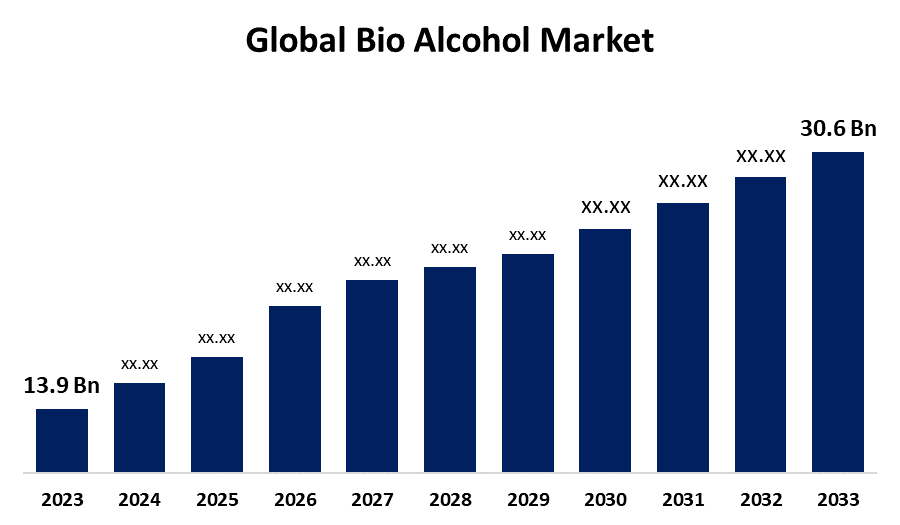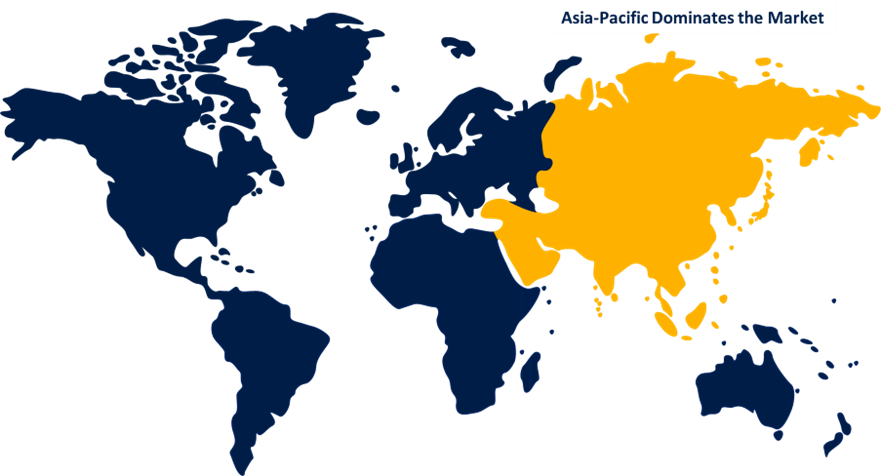Global Bio Alcohol Market Size, Share, and COVID-19 Impact Analysis, By Product (Bio methanol, Bioethanol, Biobutanol, Bio-Bdo & Others), By End User (Transportation, Construction, Electronics, Pharmaceutical, & Others), and By Region (North America, Europe, Asia-Pacific, Latin America, Middle East, and Africa), Analysis and Forecast 2023 – 2033.
Industry: Chemicals & MaterialsGlobal Bio Alcohol Market Insights Forecasts to 2033.
- The Global Bio Alcohol Market Size was Valued at USD 13.9 Billion in 2023.
- The Market Size is Growing at a CAGR of 8.21% from 2023 to 2033.
- The Worldwide Bio Alcohol Market Size is Expected to Reach USD 30.6 Billion by 2033.
- North America is expected to grow the fastest during the forecast period.

Get more details on this report -
The Global Bio Alcohol Market Size is Anticipated to Exceed USD 30.6 Billion by 2033, Growing at a CAGR of 8.21% from 2023 to 2033.
Market Overview
A particular type of alcohol called bio-alcohol, commonly referred to as bioethanol or just ethanol, is made from renewable biological resources such as cellulosic biomass or crops like corn, sugarcane, and wheat. These organic resources' sugars or starches are fermented to make it, and the concentrated alcohol is then extracted by distillation. As a greener and more sustainable fuel than fossil fuels, bioethanol is frequently used as a biofuel to run machines and automobiles. It is combined with gasoline or used pure. One of the main reasons favorably affecting the demand for bio-alcohols is the growing use of biofuels in cars as a result of strict government laws aimed at reducing vehicle carbon emissions. It can also be attributed to the increase in high-performance car sales and the global inflation of gas costs. Furthermore, because it is an affordable, sustainable, and biodegradable renewable energy source, it is utilized in building materials. This is assisting in the expansion of the market along with an increase in building activity in the commercial, industrial, and residential domains.
Report Coverage
This research report categorizes the market for the global bio alcohol market based on various segments and regions forecasts revenue growth and analyzes trends in each submarket. The report analyses the key growth drivers, opportunities, and challenges influencing the global bio alcohol market. Recent market developments and competitive strategies such as expansion, product launch, and development, partnership, merger, and acquisition have been included to draw the competitive landscape in the market. The report strategically identifies and profiles the key market players and analyses their core competencies in each sub-segment of the global bio alcohol market.
Global Bio Alcohol Market Report Coverage
| Report Coverage | Details |
|---|---|
| Base Year: | 2023 |
| Market Size in 2023: | USD 13.9 Billion in 2023 |
| Forecast Period: | 2023-2033 |
| Forecast Period CAGR 2023-2033 : | 8.21% |
| 2033 Value Projection: | USD 30.6 Billion |
| Historical Data for: | 2019-2022 |
| No. of Pages: | 200 |
| Tables, Charts & Figures: | 110 |
| Segments covered: | By Product, By End User, By Region |
| Companies covered:: | Archer Daniels Midland Company (ADM), BASF SE, Cargill, Incorporated, Dow Chemical Company, Mitsubishi Chemical Corporation, Braskem, Genomatica, Fulcrum BioEnergy, DuPont de Nemours, Inc., Novozymes A/S, Solvay SA, POET LLC, Green Plains Inc., Raízen Energia S.A., and Others Key Vendors. |
| Pitfalls & Challenges: | COVID-19 Empact,Challenges, Future, Growth, & Analysis |
Get more details on this report -
Driving factor
The global bio-alcohol drugs market is driven by various factors, including the increasing use of bio-alcohol in transportation fuel and agricultural chemicals. Bio-alcohol is a biofuel produced by fermenting organic resources. To create bio-alcohol, waste products like maize, sugar cane, or animal dung are utilized. Another resource (other than food) is the utilization of agricultural commodities cultivated specifically for the making of alcohol. Businesses that employ bio-alcohol include those in transportation and infrastructure. Many people applaud bioethanol for its renewable nature, ability to power heaters in cold climates, and lower greenhouse gas emissions as compared to traditional fuels like coal or oil. For agrochemicals, chemical intermediates, and transportation fuels, there is a growing need for bio-alcohol. In addition, the need for fossil fuels has grown dramatically during the last several decades. They are claimed to be the main contributors to global warming and are exceedingly expensive. Alcohols derived from biological sources are thought to provide an alternative to fossil fuels. Furthermore, bio-based alcohol has a large power potential, which makes large-scale fuel production from it quite feasible.
Restraining Factors
The market's expansion is hindered by the disadvantages of bioethanol, which include the need for arable land, the massive amount of carbon dioxide generated during manufacturing, and higher prices. In addition, there's concern that some farmers would forgo food crops in favor of producing biofuel since bioethanol is so profitable, driving up food prices worldwide.
Market Segmentation
The Global Bio Alcohol Market share is classified into product and end user.
- The bioethanol segment is expected to hold the largest share of the global bio alcohol market during the forecast period.
Based on the product, the global bio alcohol market is divided into bio methanol, bioethanol, biobutanol, bio-bdo and other. Among these, the bioethanol segment is expected to hold the largest share of the global bio alcohol market during the forecast period. A higher-octane fuel that used for energy-related tasks like power production is bio-ethanol. Its application in automobiles, buses, aircraft, the medical field, and fuel cells is anticipated to accelerate market expansion.
- The transportation segment is expected to hold the largest share of the global bio alcohol market during the forecast period.
Based on the end user, the global bio alcohol market is divided into transportation, construction, electronics, pharmaceutical, & others. Among these, the transportation segment is expected to hold the largest share of the global bio alcohol market during the forecast period. The worldwide market for bio alcohol is mostly driven by the approaching depletion of fossil fuels and the growing pollution issues that result from its use. The use of bio alcohol significantly reduces greenhouse gas emissions, reducing the carbon footprint of different locations. In addition, bio alcohols are a very feasible class of fuels for large-scale use due to their great power potential.
Regional Segment Analysis of the Global Bio Alcohol Market
- North America (U.S., Canada, Mexico)
- Europe (Germany, France, U.K., Italy, Spain, Rest of Europe)
- Asia-Pacific (China, Japan, India, Rest of APAC)
- South America (Brazil and the Rest of South America)
- The Middle East and Africa (UAE, South Africa, Rest of MEA)
Asia Pacific is anticipated to hold the largest share of the global bio alcohol market over the predicted timeframe.

Get more details on this report -
Asia Pacific is anticipated to hold the largest share of the global bio alcohol market over the predicted timeframe. Because end-user sectors like electronics and construction are still growing. The demand for high-performance products is steadily increasing in the region due to its large population and rising middle class wealth. Several nations in the area, including China, India, and Indonesia, are making significant investments in infrastructure and building projects.
North America is expected to grow the fastest during the forecast period. Government policies pertaining to the utilization of renewable resources have grown more stringent in North America as a result of rising carbon dioxide emissions and crude oil costs. North American governments are supporting companies producing high-performance bio-based chemicals by guaranteeing loans to them. Due to stringent government regulations pertaining to carbon emissions and the use of biofuels, Germany holds a significant market share.
Competitive Analysis:
The report offers the appropriate analysis of the key organizations/companies involved within the global bio alcohol along with a comparative evaluation primarily based on their product offering, business overviews, geographic presence, enterprise strategies, segment market share, and SWOT analysis. The report also provides an elaborative analysis focusing on the current news and developments of the companies, which includes product development, innovations, joint ventures, partnerships, mergers & acquisitions, strategic alliances, and others. This allows for the evaluation of the overall competition within the market.
List of Key Companies
- Archer Daniels Midland Company (ADM)
- BASF SE
- Cargill, Incorporated
- Dow Chemical Company
- Mitsubishi Chemical Corporation
- Braskem
- Genomatica
- Fulcrum BioEnergy
- DuPont de Nemours, Inc.
- Novozymes A/S
- Solvay SA
- POET LLC
- Green Plains Inc.
- Raízen Energia S.A.
- Others.
Key Target Audience
- Market Players
- Investors
- End-users
- Government Authorities
- Consulting And Research Firm
- Venture capitalists
- Value-Added Resellers (VARs)
Recent Developments
- In October 2022, the Neopentyl Glycol factory, which BASF plans to construct in Zhanjiang Verbund, China, is scheduled to open, BASF and Hannong Chemicals announced plans to form a joint venture for the commercial production of non-ionic surfactants in the Asia Pacific area.
Market Segment
This study forecasts revenue at global, regional, and country levels from 2020 to 2033. Spherical Insights has segmented the Global Bio Alcohol Market based on the below-mentioned segments:
Global Bio Alcohol Market, By Product
- Bio Methanol
- Bioethanol
- Biobutanol
- Bio-Bdo
- Others
Global Bio Alcohol Market, By End User
- Transportation
- Construction
- Electronics
- Pharmaceutical
- Others
Global Bio Alcohol Market, By Region
- North America
- US
- Canada
- Mexico
- Europe
- Germany
- Uk
- France
- Italy
- Spain
- Russia
- Rest of Europe
- Asia Pacific
- China
- Japan
- India
- South Korea
- Australia
- Rest of Asia Pacific
- South America
- Brazil
- Argentina
- Rest of South America
- Middle East & Africa
- UAE
- Saudi Arabia
- Qatar
- South Africa
- Rest of the Middle East & Africa
Frequently Asked Questions (FAQ)
-
1. What is bio alcohol?Alcohols made from biomass or biological resources are known as bio alcohols.
-
2. Which region has the high growth in the bio alcohol market?North America region has the high growth in the bio alcohol market
-
3. What is value of the bio alcohol market in 2023?In 2023, the global bioethanol market was estimated to be worth USD 13.9 billion.
Need help to buy this report?